![]()
![]()
![]()
Use LEFT and RIGHT arrow keys to navigate between flashcards;
Use UP and DOWN arrow keys to flip the card;
H to show hint;
A reads text to speech;
39 Cards in this Set
- Front
- Back
- 3rd side (hint)
|
Market |
Market is a group of buyers and sellers of a particular product |
|
|
|
Competitive market |
Is one with many buyers and sellers, each have a negligible effect on price |
|
|
|
Demand |
The quantity demanded of any good is the amount of the good that buyers are willing and able to purchase |
|
|
|
Law of demand |
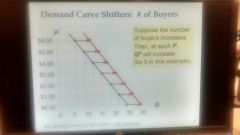
The claim that the quantity demanded of a good falls when the price of the good rises, other things equal |
|
|
|
Demand Curve Shifters |
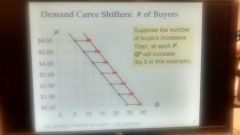
The demand curve shows how price affects quantity demanded, other things being equal.
If "other things" change, this may cause the Demand Curve to shift to the right or left. Increase in number of buyers increases quantity demanded at each price, shifts D Curve to the right |
|
|
|
Law of supply |
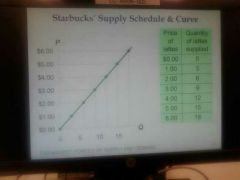
The claim that the quantity supplied of a good rises when the price of the good rises, other things equal |
|
|
|
Supply |
The quantity supplied of any good is the amount that sellers are willing and able to sell. |
|
|
|
Supply Curve Shifters |

The supply curve shows how price affects quantity supplied, other things being equal These "other things" are non-price determinants of supply. A fall in input prices makes production more profitable at each output price, so firms supply a larger quantity at each price, and the S curves to the right |
|
|
|
Equililbruim |
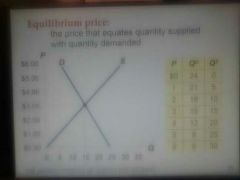
The price that equates quantity supplied with quantity demanded |
|
|
|
Surplus (a.k.a. excess supply): |
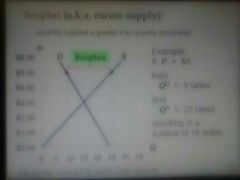
Quantity supplied is greater than quantity demanded |
|
|
|
Shortage (a.k.a. excess demand): |
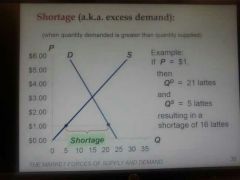
When quantity demanded is greater than quantity supplied |
|
|
|
The population in Spain is declining, immigration is discouraged. What caused the population decline? |
Two causes of high mortality rates: Harsh treatment of natives under the Encomienda system Lack of immunity of Native Americans to Europe diseases |
|
|
|
Organization of South and Central American Colonies Important economies activities: |
Silver and gold mining - Native population used as labor supply Sugar production -Native population (and later slaves) used as labor supply In long run, sugar production is more important than gold for the region |
|
|
|
In 1493, on his second voyage, who carried sugar cane seedlings to the Americas |
Christopher Columbus The sugar production process has important properties that help determine the path of economic growth in Central and South America |
|
|
|
Economics of scale |
Means that the cost of production decreases as the firm size increases |
Sugar production involves many specialized machinery. The process has many stages. Because of this, sugar cane production exhibits large _______ |
|
|
What are the similar characteristics of a sugar production? |
- large plantations with hundreds of workers - large capital requirements ( it needs lots of machinery) |
|
|
|
Sugar producing areas have ___ ____ __ ______ _________ because of technology of producing sugar has economies of scale. |
High degree of income inequality Plantations needs large amounts of labor (primarily slaves) and capital (machinery) Wealth needed to provide the capital and labor. This leads to a high concentration of wealth in sugar producing area and income inequality which is a lasting legacy in Central and South America |
|
|
|
Beginning of colonization, British population is _____ ______ and _________ is _______ |
British population is growing rapidly and immigration is encouraged Cost of transportation limited immigration |
Opposite of the situation of Spain |
|
|
What are the focus of the colonies if there was no mineral wealth (gold, silver) is found? |
Agriculture
Land is abundant - however, the land must be cleared before it is farmed - Farms are small - No economies of scale - less income inequality
|
|
|
|
Where was the first permanent settlement for English settlement in America, and what year? |
First permanent settlement is Jamestown Established by the Virginia Company of London as "James Fort" on may 4 , 1607 |
|
|
|
What was the first goals of Jamestown? |
Goal: find gold and get rich quickly The colonies did not plan to farm, instead would trade with native tribes for food. |
|
|
|
Between 1607 and 1623 in James town 4000 of 6000 total settlers had died. Average life expectancy is two years What went wrong? |
1. Conflict with local tribes, diseases, and lack of agricultural knowledge - 80% of the colonists perishing in 1609- 1610;in what became known as the "starving time" 2. Economics : institutes and incentives - properties rights |
|
|
|
Colony operated as a collective unit with all work and output shared in the beginning of Jamestown What were the results? |
Lack of incentives and motivation (People respond to incentives) |
|
|
|
For its first two and a half years, the economy of Plymouth was a communal system. What was the communal system and what was the results? |
Communal system is when food distributed equally and no division of labor. Results was lack of production, effort. |
|
|
|
If property rights are not well defined there is an incentive to shirk. What is shirk? |
Shirk - not all workers are working hard Example . - If shared equally each gets 20 bu - One worker shirks, only 90 bu are produced. - Five workers together produce 100 bu of corn.- If shared equally each gets 20 bu- One worker shirks, only 90 bu are produced. - Each gets 18bu. The shirking worker only loses 1 bu. Because he does not pay the full cost he shirks.If everyone shirks production goes down corn.- If shared equally each gets 20 bu- One worker shirks, only 90 bu are produced. - Each gets 18bu. The shirking worker only loses 1 bu. Because he does not pay the full cost he shirks.If everyone shirks production goes down - Each gets 18bu. The shirking worker only loses 1 bu. Because he does not pay the full cost he shirks.If everyone shirks production goes down . If everyone shirks production goes down |
|
|
|
Why do property rights change in both Plymouth and Jamestown? |
Starvation provides an incentive to change institutions - in both colonies, over time, land was allotted to families and individuals and productivity increased. |
|
|
|
What is the "Tragedy of the Commons" |
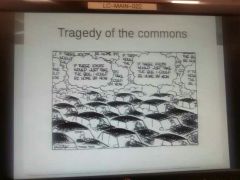
Common ownership of property has two characteristics : - compensation is average of what is produced - No one has right to exclude people from using resources The results is that common property will be used until its value is zero |
|
|
|
How does Tragedy of the Commons relate to Jamestown ? |
The farming is done by the community and the benefits are equally divided. A farmer in Jamestown might realize that if he works a bit less, the average food available per person will fall by only a very small amount. If all people come to this conclusion, however, and all work fewer hours, food production will drastically decline. |
|
|
|
What are the solution of Tragedy of the Commons (property rights)? |
Solution: private property Private: incentive to keep its value, so the owners can sell it.
Public: everyone in the community to use the area but if too many use it, it'll be destroyed. |
|
|
|
By 1175, more than 500,000 Europeans had made the transatlantic voyage to North America. How did they afford this trip? |
Approximately 70% of these settlers came over via the use an indenture contract. |
|
|
|
Why did so many people come to the colonies? What were the problems? |
An abundance of land and lack of labor in the New World makes labor more productive and therefore wages are higher in the colonies. The problem the cost of a transatlantic voyage is too high for the average laborer. |
|
|
|
Indenture contract / servitude |
A contract to work over in America and someone will lay them to go over there Made between immigrant and shipper Worker agreed to work a set number of years to pay the cost of transport to the colonies. When ship landed in colony, shippers would sell the contract to merchant of business owner compensating him for the cost of voyage. |
|
|
|
What are the demand and supply for indenture contracts? |
Demand comes from workers who want to immigrate to Colonies but cannot afford transport Supply comes from shippers |
|
|
|
What type of person would shippers like to ship over to the colonies? |
Galenson (an Economic Historian) looks at people who are indentured servants - most are males in late teens or early twenties - many are literate - 1/3 are skilled and this increases over time - very few convicts or low productivity workers ( most are strong workers) |
|
|
|
Why do indenture contracts disappear? |
Indenture contracts end as transportation costs decrease and incomes in Europe increase - Also colonists send money back to pay for the passage for new immigrants - They are not made illegal at the time |
|
|
|
Is slavery the same as indenture contracts? |
No, Slavery is not voluntary
No contracts or legal rights for slaves
Indenture contracts were enforceable in courts
Indentured servants were still citizens with rights
Not clear that slaves and indentured servants are used as substitutes.
Slaves used mostly in South and rural areas.
|
|
|
|
Why was Slavery in the south? |
Economic Reason: Crops (rice, indigo, tobacco) exhibit economies of scale. Large plantations with large labor units under supervision. Geographic (?) Reason: Black has greater resistance to tropical diseases and had lower death rates than early white colonists in the southern colonies. |
|
|
|
Two choices; hire labor or use slaves Compare and contrast |
Cost of free hired labor: Wages rate plus the monitoring cost
Cost of slave labor: Maintenance cost plus the monitoring cost.
Monitoring cost is higher for slaves than for hired labor
Also, must maintain slaves when labor is not used. Slave labor is not the low cost method of production for most Crops. |
|
|
|
What are most slaves brought to the Americas are used for? |
Most slaves brought in the Americas are used in sugar production - sugar is not a major crop produced in original 13 colonies |
|

